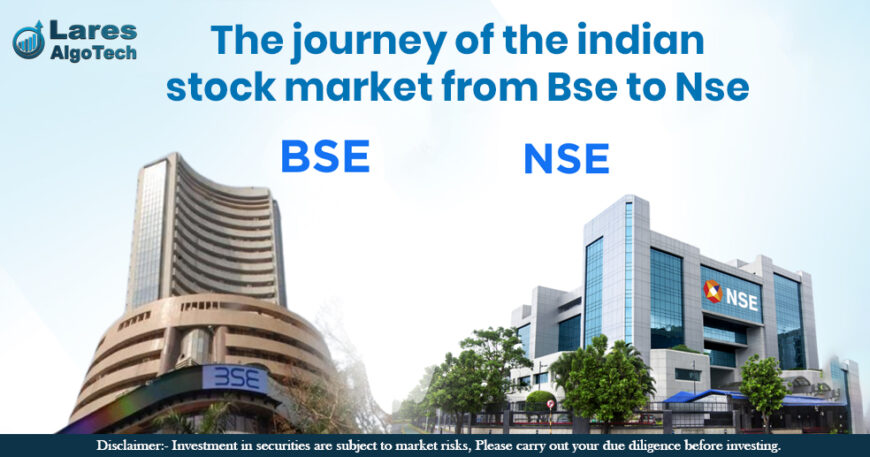Introduction: The Evolution of India’s Financial Pulse
The Indian stock market has witnessed a remarkable transformation over the last century — from open-outcry trading floors to sophisticated electronic exchanges, from regional broker circles to globally integrated digital platforms. At the heart of this evolution stand two institutions that have defined India’s capital-market landscape: the Bombay Stock Exchange (BSE) and the National Stock Exchange (NSE).
For investors and traders, understanding this journey isn’t just a history lesson — it’s a roadmap to how technology, transparency, and regulation have shaped modern trading. For innovators like Lares Algotech, which blends algorithmic intelligence with brokerage expertise, the BSE-to-NSE story offers key insights into how India built one of the world’s most efficient financial ecosystems.
The Birth of the BSE: India’s First Organized Exchange
Founded in 1875, the Bombay Stock Exchange (BSE) began under a banyan tree in Mumbai’s Dalal Street — with just a few brokers exchanging shares of textile mills. It became Asia’s first stock exchange, long before many Western markets had formal trading systems.
The early decades were driven by:
- India’s industrialization under the British Raj.
- Local merchant families trading in cotton, jute, and railways.
- Limited investor participation, as capital markets were largely opaque and unregulated.
By the mid-20th century, the BSE was home to hundreds of companies. Yet, trading was manual, slow, and dependent on brokers’ calls and handwritten contracts.
The Pre-Liberalization Era: Limited Access and Manual Trading
Until the early 1990s, the Indian stock market remained largely closed, regional, and fragmented. Trading was conducted through the open-outcry system, where brokers shouted bids and offers on the floor. Settlements took weeks, and price manipulation was common due to the absence of transparent data.
Key challenges before 1991:
- Paper-based settlements leading to delays and errors.
- Lack of investor protection laws.
- Limited participation from retail investors or foreign institutions.
- Rampant speculation with little oversight.
Despite these limitations, the BSE symbolized India’s emerging capitalist energy — though reforms were desperately needed to modernize the system.
The 1991 Economic Reforms: Opening the Doors to Modern Finance
The watershed moment came in 1991, when India faced a balance-of-payments crisis and launched sweeping economic liberalization under Dr. Manmohan Singh. The new policy emphasized privatization, globalization, and market-driven growth — triggering a revolution in financial infrastructure.
Reforms that shaped the market included:
- Introduction of Securities and Exchange Board of India (SEBI) as the regulatory authority.
- Opening the market to Foreign Institutional Investors (FIIs).
- Permission for private sector exchanges to operate under strict regulation.
These changes paved the way for the launch of a new-age exchange — the National Stock Exchange (NSE) — which would soon redefine Indian trading forever.
The Rise of the NSE: India’s Digital Financial Revolution
Established in 1992 and operational by 1994, the National Stock Exchange of India Ltd. (NSE) was designed to bring transparency, efficiency, and technology to Indian markets. Unlike the BSE’s traditional model, NSE introduced:
- Fully automated electronic trading through the NEAT system (National Exchange for Automated Trading).
- Nationwide connectivity, allowing investors from any part of India to trade online.
- Order-driven system replacing broker-driven price discovery.
Within a few years, the NSE overtook the BSE in trading volume — thanks to its technological superiority, faster settlement cycles, and stronger focus on investor protection.
The Battle of the Exchanges: BSE vs. NSE
The competition between BSE and NSE was both fierce and transformative. Each pushed the other to innovate and expand.
| Parameter | BSE | NSE |
| Founded | 1875 | 1992 |
| Trading Type | Open-outcry (earlier), now electronic | Fully electronic from inception |
| Benchmark Index | SENSEX | NIFTY 50 |
| Technology Adoption | Gradual modernization | Rapid, end-to-end automation |
| Market Share (by volume) | Lower | Higher |
| Global Ranking | Oldest in Asia | Largest in India by turnover |
The BSE Sensex, launched in 1986, became India’s first benchmark index, representing 30 major companies. The NSE Nifty 50, introduced in 1996, represented a more diversified set of sectors and soon became the preferred barometer for institutional investors.
Dematerialization and Depositories: The End of Paper Shares
Before the 1990s, investors had to hold physical share certificates, a tedious process vulnerable to theft, forgery, and delays. The establishment of National Securities Depository Limited (NSDL) in 1996, followed by Central Depository Services Limited (CDSL), introduced dematerialization — converting paper shares into digital form.
This innovation:
- Reduced settlement cycles from weeks to T+2.
- Eliminated fake or duplicate share certificates.
- Allowed seamless transfer of ownership.
Demat accounts also democratized investing — paving the way for today’s retail participation boom that firms like Lares Algotech now empower through digital trading and AI-driven analytics.
The Role of SEBI: Regulating and Reforming the Market
The Securities and Exchange Board of India (SEBI), established in 1988 and given statutory powers in 1992, became the guardian of fair trading. SEBI introduced:
- Strict disclosure norms for listed companies.
- Insider-trading laws and penalties.
- Regulations for mutual funds, derivatives, and brokers.
- Guidelines for algorithmic and high-frequency trading (HFT).
By promoting transparency, investor education, and technology, SEBI helped build investor confidence, attracting global capital inflows.
The Derivatives Boom: Futures, Options, and Hedging
In 2000, the NSE introduced derivatives trading, beginning with index futures and options. This marked a turning point in how investors managed risk.
Benefits of derivatives:
- Enabled hedging against market volatility.
- Allowed speculative and arbitrage strategies.
- Boosted liquidity and price discovery.
Today, India’s derivatives market ranks among the largest in the world by contract volume — a space where Lares Algotech operates actively, providing traders with intelligent, rule-based algorithms to manage risk and enhance accuracy.
Technology and the Rise of Algorithmic Trading
From the early 2000s to today, technology has become the backbone of India’s capital markets. The introduction of co-location servers, API-based access, and low-latency networks gave rise to algorithmic and high-frequency trading.
Key milestones:
- 2008: SEBI allowed algorithmic trading for institutional players.
- 2010s: Expansion of smart order routing and direct market access.
- 2020s: Retail adoption of AI-powered tools like Bull8 Algo, developed in partnership with Lares Algotech.
Algorithmic trading now contributes to over 60% of market volume, driven by automation, back-testing, and real-time analytics.
The Shift to Retail Participation and Fintech Integration
Over the past five years, India has seen an explosion of retail investors, thanks to:
- Mobile trading apps.
- Low-cost brokerages.
- Growing financial awareness post-COVID.
According to NSE data, India crossed 12 crore demat accounts in 2024 — a 400% increase since 2019. Retail investors now contribute nearly 45% of daily turnover, a trend accelerated by platforms integrating AI and automation.
This is precisely where Lares Algotech bridges the gap — offering retail algo trading solutions that combine institutional-grade strategy execution with user-friendly design.
NSE’s Innovations: From Trading to Market Intelligence
The NSE’s continuous innovation kept it ahead of global trends. Some key initiatives include:
- NSE IFSC (International Financial Services Centre) at GIFT City for global investors.
- NSE Clearing Ltd. for robust settlement and risk management.
- NSE Data and Research Services, enabling analytics-driven trading.
- AI surveillance to detect unusual market activity.
By integrating technology with governance, the NSE ensured that Indian markets remain competitive, secure, and future-ready.
The BSE’s Reinvention: Staying Relevant in the Digital Era
While NSE became dominant in trading volume, BSE reinvented itself by focusing on:
- SME platform for small-cap companies.
- BSE StAR MF, India’s largest mutual-fund distribution platform.
- BSE Hi-Tech, promoting startups and innovation.
- Launching BSE E-Agriculture Markets for commodities.
This adaptability ensured that the world’s oldest exchange stayed relevant even in a digital-first economy.
Global Recognition: India as a Top 5 Market
Today, India’s stock market ranks among the top five globally in market capitalization — exceeding $5 trillion in 2025. The NSE and BSE together list over 7,000 companies, serving as engines of wealth creation and entrepreneurship.
The key drivers of global recognition:
- Stable regulatory framework by SEBI.
- Transparent trading infrastructure.
- Digital inclusion and financial literacy.
- Integration of AI, fintech, and data analytics.
India’s markets are no longer seen as “emerging” — they are emerged and expanding.
The Role of Technology Firms Like Lares Algotech
As the markets evolved from manual trading to machine-driven intelligence, firms like Lares Algotech became central to the new era of trading innovation.
Lares Algotech:
- Is a SEBI-registered stockbroking firm and a member of NSE, BSE, and MCX.
- Builds AI-powered trading systems that enhance accuracy, speed, and compliance.
- Enables retail traders to use institutional-grade algorithms through intuitive platforms like Bull8 Algo.
- Focuses on risk-first automation, quantitative models, and data-driven decision making.
In essence, Lares Algotech represents the logical next step in the Indian market’s journey — where the fusion of human intelligence and artificial intelligence empowers every investor.
The SEBI Retail Algo Framework (2025 Onwards)
With SEBI’s Retail Algo Trading Guidelines (effective October 1, 2025), India is entering a new phase of democratized algorithmic participation.
The framework:
- Mandates broker-verified algorithms.
- Ensures exchange-level risk checks and approvals.
- Prevents misuse of untested or unregulated algos.
- Empowers retail traders to use pre-built, approved strategies safely.
Lares Algotech, in collaboration with Bull8, is among the pioneers preparing for this retail-algo revolution — ensuring compliance, safety, and profitability for every investor.
The Future: Smart, Regulated, and Inclusive
Looking ahead, the Indian stock market is poised to integrate:
- AI-driven predictive analytics.
- Blockchain-based settlements.
- Cross-border digital asset exchanges.
- Robo-advisory and quant-driven portfolio management.
As technology and regulation converge, the market’s focus will shift from speculative trading to data-backed wealth creation.
Lares Algotech envisions a future where every trader — retail or institutional — trades intelligently, safely, and profitably.
Conclusion: From Dalal Street to Digital Screens
The journey of the Indian stock market — from the BSE’s banyan tree beginnings to the NSE’s electronic revolution — is a story of vision, reform, and resilience.
It mirrors India’s economic rise from a closed economy to a global powerhouse.
Today, with platforms like Lares Algotech and Bull8 Algo, this journey continues — evolving from open-outcry to AI-driven accuracy, from paperwork to predictive analytics, from brokers to smart algorithms.
As India embraces the future of regulated retail algorithmic trading, one truth stands clear:
The legacy of the BSE and the innovation of the NSE have built the foundation — but technology partners like Lares Algotech are building the future.






 .facebook.com/lares.algotech
.facebook.com/lares.algotech  instagram.com/laresalgotech/
instagram.com/laresalgotech/  x.com/AlgoLares
x.com/AlgoLares  whatsapp.com/channel/...
whatsapp.com/channel/...  .linkedin.com/company/lares-algotech/
.linkedin.com/company/lares-algotech/  youtube.com/@LaresAlgoTech
youtube.com/@LaresAlgoTech